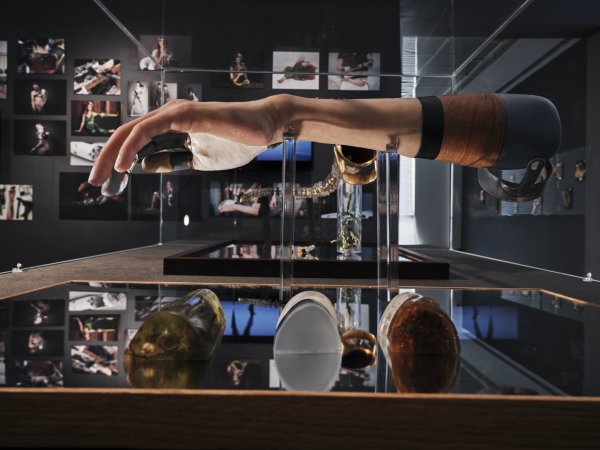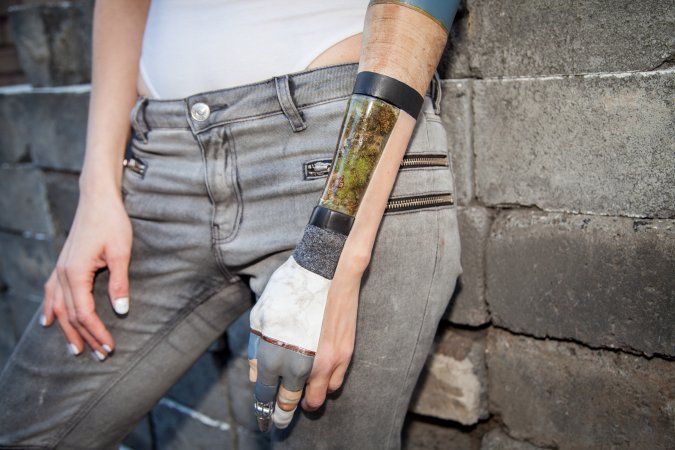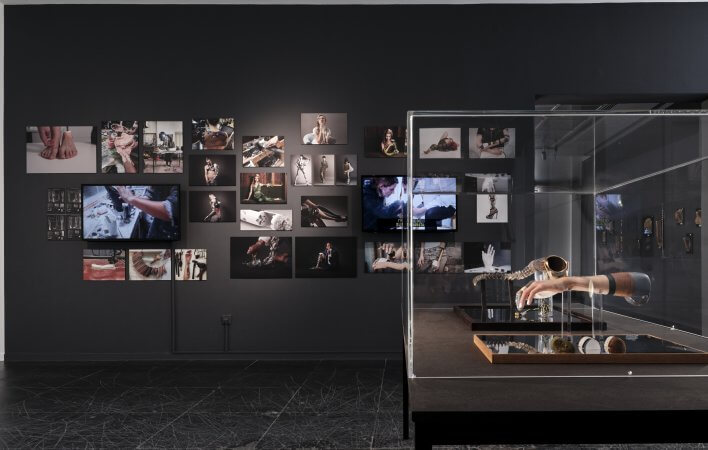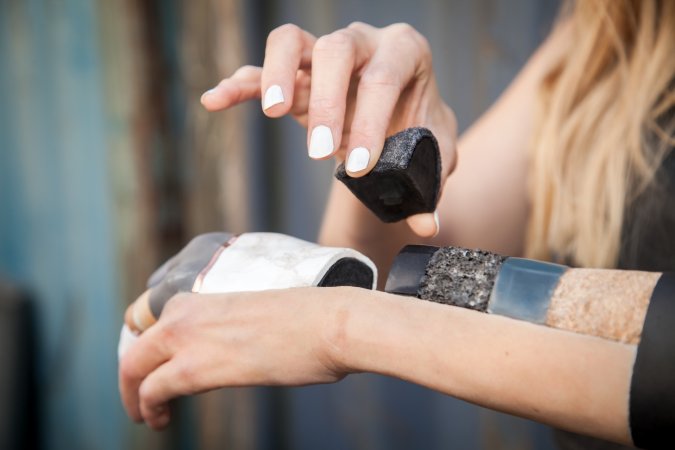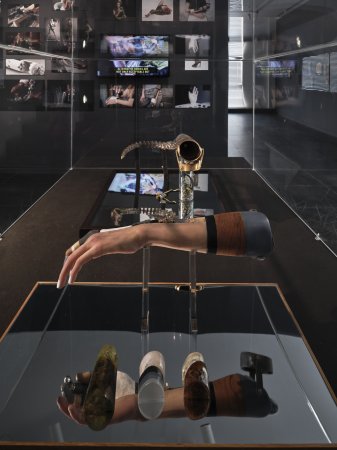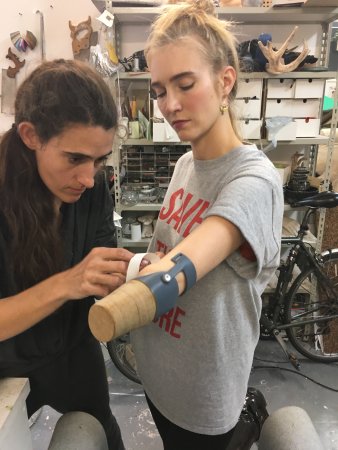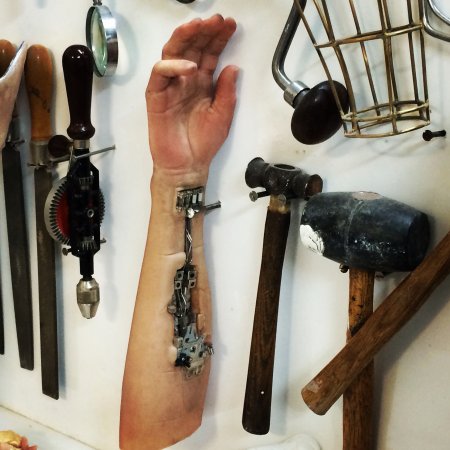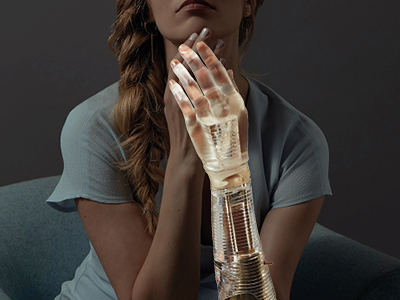The Alternative Limb Project
Materialise, 2015
Arm prosthesis
3D printing, CNC routing, hand carved and sculpted, using steel, rock, earth, wood, moss, oil, cork, wool, bronze, rhodium, gold and magnets
50 x 13 x 13 cm
VINE 2.0, 2022
Arm prosthesis
Resin, electronics, metal components and gold plated metal
70 x 14 x 14 cm
Photo and video installation with photos by Rosie Williams, Ewelina Stechnij, Louie Banks, Lukasz Suchorab, Omkaar Kotedia, Rosemary Williams, Simon Clemenger, Andrew Perris
Courtesy The Alternative Limb Project
Sophie de Oliveira Barata is a designer, artist and prosthetist. She works with people who, through artistic and artificial enhancement, create and wear a self-empowering form of their body. The word ‘prosthesis’ derives from the Greek ‘to add’. In the medical sense it refers to an artificial body part that replaces a missing limb. Yet in the context of The Alternative Limb Project, addition means more. It isn’t simply about supplementing the body or replacing a lost limb. Her ‘alternative limbs’ are an empowerment of personality. They are an expression of a body that, through our own narratives, assumes a self-selected, extended form.
The absence of a limb—whether from birth, through accident or due to medical necessity—has long been associated with social stigmatisation. The idea of a body that doesn’t conform to the norm is often a factor in the exclusion and shame experienced by those affected. Prostheses can partly compensate for the body’s missing functions, and with advancing technology, this can now be done in such a way that the distinction between the body and the artificial part is largely unobtrusive and invisible.
Sophie de Oliveira Barata, however, represents a practice that not only provides wearers with a functional prosthesis, but develops with them a concept of proud otherness. It is about the empowerment of their being and the wearing of an ornament that extends their bodies and embodies the uniqueness of the wearer. For this reason, de Oliveira Barata, deliberately, doesn’t call her objects prostheses, instead, provocatively, she calls them ‘alternative limbs’ where the ‘alternative’ stands for expansion and inimitability.
De Oliveira Barata’s work brings together science, technology, medicine and art. Behind each of her projects and objects stands an individual person, with their own story and psychology. Today, de Oliveira Barata collaborates with a wide range of trades and specialists, including electronics engineers, mechanical engineers, prosthetic technicians, traditional craftspeople (such as woodcarvers), metalworkers and jewellery designers. In addition to extensive handcraft, she also employs techniques such as 3D printing and computer-assisted milling.
After studying art, de Oliveira Barata began her career in film, in special effects. She then moved into the medical field, where she spent eight years working in a rehabilitation centre with people who had undergone amputations. Following this, she decided to move beyond simply producing hyperrealistic replicas and instead work with those affected to develop prostheses as forms of artistic and personal expression. Where initially the aim had been realism—to give prostheses an appearance as close to natural limbs as possible and to achieve visual continuity with the body—she broadened her ambition by creating artefacts that tell the story of the individual. Bodies change in their vitality and variability: skin tone shifts with circulation or exposure to the sun and body shape alters with the time of day, weight fluctuation or ageing. And the static nature of the prosthesis remains in contrast to this.
The creation of hyperrealistic limbs begins with a foam mould that replicates the missing body part. A silicone cast is then produced, tailored precisely to the body. Skin surfaces are built up from silicone, tinted with pigments and applied in many layers until the natural skin tone is achieved. To reproduce the translucency of real skin, the material is stretched and threaded with fine fibres. The details then follow—moles, scars, freckles, wrinkles or tattoos—and all can be added individually. Nails, too, are adjusted in shape, colour and length, with nail polish available on request. Clients are involved throughout the entire process and decide which details matter most to them. The result is a piece so lifelike that it blends seamlessly into the wearer’s life.
When the aim is not deception but expression, de Oliveira Barata works with greater freedom. The prosthesis becomes a sculpture, an accessory or a work of art. Here, too, everything begins with dialogue: what does the wearer wish to reveal, what story should the object tell? The team brings together a wide range of handcraft techniques to create a unique piece.
De Oliveira Barata recognised early on that people longed for more than the mere replacement of a missing limb and its function. What they sought was healing. She set out in search of individuals who would join her in developing a new approach to artificial limbs. The first was Viktoria Modesta, a British singer and model, and soon others followed—Paralympic athletes, musicians, artists, former soldiers—all realising their dream of a functional extension to their bodies. They wear their ‘alternative limbs’ with pride; they stand as expressions of their personality and identity.
What is different—and in a majority society may still be regarded as abnormal—is here transformed into adornment, into an affirmative gesture not of concealment but of celebration. Playful, bold, humorous and beautiful, rather than a posture of victimhood that invites pity. This completely alters relationships and self-image.
De Oliveira Barata’s prostheses don’t hide physical differences, they reveal them. They transform them into something special and endow them with their own power. “I like making these pieces”, she emphasises, “because the conversations change, from pity to wonder.” The ‘alternative limbs’ open up a dialogue about the idea of the human body and differences in body images, and they celebrate them.
“When people wear their alternative prostheses, their posture often changes”, says Sophie de Oliveira Barata. “That is because they have been involved in the process of creation—and because the pieces attract attention. Instead of pity, they encounter curiosity, sometimes even admiration. That gives them strength. Some wear their prostheses on special occasions, slipping into a kind of alter ego. Others make them a permanent part of their identity.”
The exhibition Anatomy of Fragility at the Frankfurter Kunstverein presents two works from the series of The Alternative Limb Project. One was created as a functional prosthesis, the other as an object in which aesthetic concerns take precedence.
Materialise is an alternative arm created for activist and model Kelly Knox. It’s divided lengthwise into two halves, one side consists of silicone skin, the other of a multitude of materials: steel, stone, earth, wood, moss, oil, cork, wool, bronze, rhodium and gold. Depending on her mood and state of mind, the wearer can interchange the elements. This alters not only the texture but also the weight of the arm. Kelly Knox decides for herself how she wishes to wear it.
The arm was produced using 3D-printing and CNC-milling techniques, alongside extensive handcraft and artisanal work. The skin side is a realistic reproduction of the wearer’s right arm in a silicone-like material, representing Kelly Knox’s physical self. The choice of materials embodies the individual, emotional and spiritual dimensions of her personality.
Another model, VINE 2.0, was also created for Kelly Knox. This ‘alternative limb’ distances itself even more decisively from the idea and aesthetics of realistic-looking limbs. The arm becomes a tentacle-like structure made up of 26 vertebral segments. The wearer controls the arm’s movements using pressure sensors in the shoe and artificial tendons contract or loosen, producing fluid motions. Through an electromagnet, the prosthesis connects to a metal fixture on the body via a clip-on system. Circuits, batteries and sensors now transmit the organism’s impulses via Bluetooth to the alternative body part.
VINE 2.0 seems to pay tribute to the thinker Donna Haraway. Under the concept of ‘tentacular thinking’, she questions a world view in which humans, with their specific corporeality and needs, elevate themselves to the centre of creation. Haraway advocates overcoming the typically Western mode of thinking in dualisms: human–animal, nature–technology and body–mind. The future of identity and the body arises beyond these. In A Cyborg Manifesto, Haraway chooses the figure of a hybrid being—part biological organism, part machine—as a metaphor for emancipatory purposes and for overcoming patriarchal structures.
For Anatomy of Fragility, the Frankfurter Kunstverein has assembled a comprehensive selection of documentary films, photographs and technical drawings in collaboration with Sophie de Oliveira Barata. As the numerous objects belong to their wearers, it is they who bear witness to this unique body of work.
The Alternative Limb Project was founded by Sophie de Oliveira Barata (*1982 in London, UK). Her works have been exhibited internationally in institutions such as the National Museum of Scotland in Edinburgh (UK); the Musée de l’Homme in Paris (FR); Ars Electronica in Linz (AUT); the Museum of Science and Industry in Chicago (USA); the Science Museum in London (UK); Museum Arnhem (NL) and Museum Ulm (DE). Sophie de Oliveira Barata gives regularly lectures internationally, most recently at TED X in London (UK); TED MED in San Francisco (USA); and the Henry Moore Institute in Leeds (UK).

